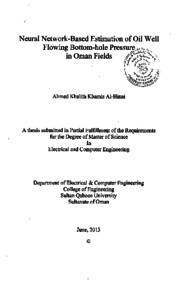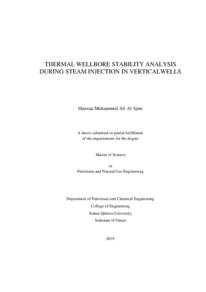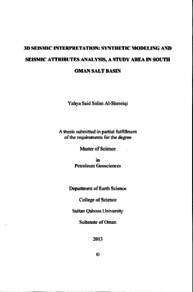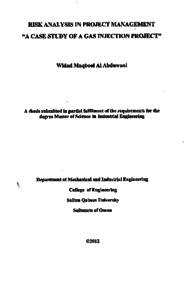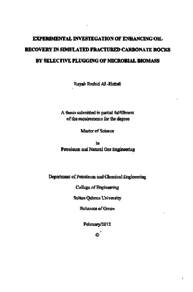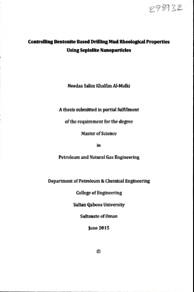Document
Neural network-based estimation of oil well flowing bottom-hole pressure in Oman fields
Publisher
Sultan Qaboos University
Gregorian
2013
Language
English
Subject
English abstract
The flowing bottom-hole pressure (FBHP) of an oil well is important information for reservoir engineers and production technologies. It is an essential parameter to enable well production forecasting, production monitoring and well artificial lift system optimization. Therefore, the installation of down-hole gauges in oil wells has become a common practice in the oil petroleum industry; especially in wells lifted with electrical submersible pumps. However, these down-hole gauges require continuous maintenance and calibration. Also, due to the harsh down-hole environment there is a high risk they will fail and will be expensive to repair or replace. In addition, intervening a well from time to time to measure the FBHP is an expensive task and associated with production risk and interruption. For these reasons the motivation of the estimation of the FBHP has come out.
Estimating the FBHP of wells with multiphase flow is a challenging and very complex problem. Experience has shown that empirical correlations and mechanistic models failed to provide a satisfactory and reliable tool for estimating pressure drop in multiphase flowing wells. Large errors are usually associated with these models and correlations. The recent development and success of applying artificial neural networks (ANN) to solve various difficult and complex engineering problems has drawn the attention to its potential applications in the petroleum industry. With regard to this field, few researchers applied ANN techniques to resolve some problems associated with multiphase problems including pressure drop estimations.
The objective of this study is to develop an ANN model to estimate the FBHP in vertical oil wells by using measured data from oil fields of Oman. This is achieved by designing and developing a multilayer perceptrons feedforward neural network (FFNN) with backpropagation algorithm. The selection of the best number of hidden layers is done through trial and performance assessment. Similarly, the best number of neurons in each hidden layer is selected. Also, a radial basis function neural network model is developed and compared to the single and two hidden layers models performance. The best neural network model performance is also compared against an empirical model developed to calculate the FBHP using available input data. The software package used is the MATLAB Neural Networks Toolbox 2009 edition. Field data is used to train and test the model. Field data has been gathered from pumped oil wells from Oman oil fields. Model inputs data were selected from the list of available surface well measurements. Data is preprocessed prior to training and testing processes. The model performance evaluation conducted by means of testing the model against actual well down-hole measurements data from the same oil fields. These testing data have not been used in the model training. Standard statistical analyses preformed on the results to evaluate the models estimation accuracy such as; root mean square error, standard deviation of error, minimum/maximum/average absolute relative error and correlation coefficient. These statistical analyses have shown that the FFNN has a very strong ability in estimating the FBHP compared to the empirical formula.
Member of
Resource URL
Arabic abstract
الملخص إن ضغط تدفق قاع بنر النفط هو من المعلومات الهامة لمهندسي مكامن النفط وتقنيي الإنتاج لأنه يعد عنصرة أساسية التمكين التنبؤ بإنتاج آبار النفط، ومراقبة إنتاجها وتحسين أداء نظام الرفع الاصطناعي. ولذلك، أصبح تركيب أجهزة قياس ضغط التدفق في قاع آبار النفط ممارسة شائعة في صناعة النفط، خصوصا في الآبار التي يتم انتاجها بواسطة المضخات الكهربائية الغاطسة.
تتطلب أجهزة قياس ضغط التدفق صيانة ومعايرة مستمرة كي يتسنى لها إستمرارية القياس بدقة. أيضا، بسبب البيئة القاسية في قاع البئر فإن هناك مخاطر عالية قد تؤدي الى فشل وتعطل هذه الأجهزة، وسوف تكون مكلفة الإصلاح أو الإستبدال. وبالإضافة إلى ذلك، فإن قطع إنتاج البتر من وقت لآخر لقياس ضغط تدفق قاع البئر لهو مهمة مكلفة ويترافق معها مخاطر إنقطاع الإنتاج. فلهذه الأسباب جميعا ظهر الدافع لمحاولة التنبؤ بقيمة ضغط تدفق قاع البئر حسابيا.
إن تقدير ضغط تدفق قاع البئر مع تدفق موانع متعددة الأطوار هي مشكلة صعبة ومعقدة للغاية. وقد أظهرت التجربة أن الارتباطات التجريبية والنماذج الآلية فشلت في توفير أداة مرضية وموثوق بها لتقدير انخفاض الضغط في الآبار المتدفقة بموانع متعدد الأطوار. وعادة ما ترتبط أخطاء كبيرة مع هذه النماذج والارتباطات.
في الأونة الأخيرة وجه تطوير ونجاح تطبيق الشبكات العصبية الاصطناعية (ANN) لحل مختلف المشاكل الهندسية الصعبة والمعقدة الإنتباه إلى تطبيقاتها المحتملة في مجال الصناعة النفطية. وفيما يتعلق بهذا المجال، فإن هناك قلة من الباحثين قاموا بتطبيق تقنية الشبكات العصبية الاصطناعية لحل المشاكل المرتبطة بمشاكل تدفق موانع متعدد الأطوار بما في ذلك تقديرات انخفاض الضغط.
إن الهدف من هذه الدراسة هو تطوير نموذج شبكات عصبية إصطناعية لتقدير ضغط تدفق قاع البئر في آبار النفط العمودية باستخدام بيانات قیاسات سطحية من حقول نفط في سلطنة عمان. ويتحقق ذلك من خلال تصميم وتطوير شبكة عصبية إصطناعية لمستقبلات متعدد الطبقات ذات التغذية الأمامية (FFNN) مع خوارزمية الانتشار الخلفي (BP). وتم اختيار العدد الأفضل من الطبقات المخفية من خلال التجربة وتقييم الأداء. وبالمثل، تم تحديد العدد الأفضل من الخلايا العصبية في كل طبقة مخفية. كما تم تطوير نموذج بإستخدام تقنية الشبكة العصبية ذات القاعدة الشعاعية (RBFNN) وتج مقارنة أدائه مع أداء نماذج الشبكة العصبية ذات الطبقات المخفية. كذلك تم مقارنة أداء أفضل نموذج من نماذج الشبكة العصبية مع نموذج تجريبي وضع لحساب ضغط تدفق قاع البتر باستخدام بيانات المدخلات المتاحة. إن جزمة البرمجيات الحسابية المستخدمة هي أدوات الشبكات العصبية المتوفرة في برنامج MATLAB طبعة عام 2009.
وقد تم استخدام بيانات ميدانية لتعليم واختبار النموذج. كما تم جمع البيانات الميدانية من آبار حقول نفط بسلطنة عمان. وقد تم اختيار بيانات مدخلات النموذج من قائمة القياسات السطحية المتاحة لأبار النفط. علما أنه تم معالجة البيانات مسبقا قبل عمليات التدريب والاختبار. أما تقييم أداء النماذج فقد أجري عن طريق مقارنة نتائجها مع بيانات قیاسات ضغط تدفق قاع البئر الفعلية والمسجلة من نفس حقول النفط. والجدير بالذكر أن بيانات الإختبار هذه لم تستخدم في تدريب النموذج. وقد تم تطبيق بعض التحليلات الإحصائية القياسية على نتائج النماذج لتقييم دقة تقديراتها، ومن أمثلة هذه الأحصائيات؛ جذر متوسط مربع الخطأ والانحراف المعياري للخطأ، والحد الأدنى / الأقصى ومتوسط الخطأ النسبي المطلق ومعامل الارتباط. وقد أظهرت هذه التحليلات الإحصائية أن الشبكة العصبية الإصطناعية ذات التغذيه الأمامية لديها قدرة قوية جدا في تقدير ضغط تدفق قاع البئر بالمقارنة مع النموذج التجريبي.
تتطلب أجهزة قياس ضغط التدفق صيانة ومعايرة مستمرة كي يتسنى لها إستمرارية القياس بدقة. أيضا، بسبب البيئة القاسية في قاع البئر فإن هناك مخاطر عالية قد تؤدي الى فشل وتعطل هذه الأجهزة، وسوف تكون مكلفة الإصلاح أو الإستبدال. وبالإضافة إلى ذلك، فإن قطع إنتاج البتر من وقت لآخر لقياس ضغط تدفق قاع البئر لهو مهمة مكلفة ويترافق معها مخاطر إنقطاع الإنتاج. فلهذه الأسباب جميعا ظهر الدافع لمحاولة التنبؤ بقيمة ضغط تدفق قاع البئر حسابيا.
إن تقدير ضغط تدفق قاع البئر مع تدفق موانع متعددة الأطوار هي مشكلة صعبة ومعقدة للغاية. وقد أظهرت التجربة أن الارتباطات التجريبية والنماذج الآلية فشلت في توفير أداة مرضية وموثوق بها لتقدير انخفاض الضغط في الآبار المتدفقة بموانع متعدد الأطوار. وعادة ما ترتبط أخطاء كبيرة مع هذه النماذج والارتباطات.
في الأونة الأخيرة وجه تطوير ونجاح تطبيق الشبكات العصبية الاصطناعية (ANN) لحل مختلف المشاكل الهندسية الصعبة والمعقدة الإنتباه إلى تطبيقاتها المحتملة في مجال الصناعة النفطية. وفيما يتعلق بهذا المجال، فإن هناك قلة من الباحثين قاموا بتطبيق تقنية الشبكات العصبية الاصطناعية لحل المشاكل المرتبطة بمشاكل تدفق موانع متعدد الأطوار بما في ذلك تقديرات انخفاض الضغط.
إن الهدف من هذه الدراسة هو تطوير نموذج شبكات عصبية إصطناعية لتقدير ضغط تدفق قاع البئر في آبار النفط العمودية باستخدام بيانات قیاسات سطحية من حقول نفط في سلطنة عمان. ويتحقق ذلك من خلال تصميم وتطوير شبكة عصبية إصطناعية لمستقبلات متعدد الطبقات ذات التغذية الأمامية (FFNN) مع خوارزمية الانتشار الخلفي (BP). وتم اختيار العدد الأفضل من الطبقات المخفية من خلال التجربة وتقييم الأداء. وبالمثل، تم تحديد العدد الأفضل من الخلايا العصبية في كل طبقة مخفية. كما تم تطوير نموذج بإستخدام تقنية الشبكة العصبية ذات القاعدة الشعاعية (RBFNN) وتج مقارنة أدائه مع أداء نماذج الشبكة العصبية ذات الطبقات المخفية. كذلك تم مقارنة أداء أفضل نموذج من نماذج الشبكة العصبية مع نموذج تجريبي وضع لحساب ضغط تدفق قاع البتر باستخدام بيانات المدخلات المتاحة. إن جزمة البرمجيات الحسابية المستخدمة هي أدوات الشبكات العصبية المتوفرة في برنامج MATLAB طبعة عام 2009.
وقد تم استخدام بيانات ميدانية لتعليم واختبار النموذج. كما تم جمع البيانات الميدانية من آبار حقول نفط بسلطنة عمان. وقد تم اختيار بيانات مدخلات النموذج من قائمة القياسات السطحية المتاحة لأبار النفط. علما أنه تم معالجة البيانات مسبقا قبل عمليات التدريب والاختبار. أما تقييم أداء النماذج فقد أجري عن طريق مقارنة نتائجها مع بيانات قیاسات ضغط تدفق قاع البئر الفعلية والمسجلة من نفس حقول النفط. والجدير بالذكر أن بيانات الإختبار هذه لم تستخدم في تدريب النموذج. وقد تم تطبيق بعض التحليلات الإحصائية القياسية على نتائج النماذج لتقييم دقة تقديراتها، ومن أمثلة هذه الأحصائيات؛ جذر متوسط مربع الخطأ والانحراف المعياري للخطأ، والحد الأدنى / الأقصى ومتوسط الخطأ النسبي المطلق ومعامل الارتباط. وقد أظهرت هذه التحليلات الإحصائية أن الشبكة العصبية الإصطناعية ذات التغذيه الأمامية لديها قدرة قوية جدا في تقدير ضغط تدفق قاع البئر بالمقارنة مع النموذج التجريبي.
Category
Theses and Dissertations

